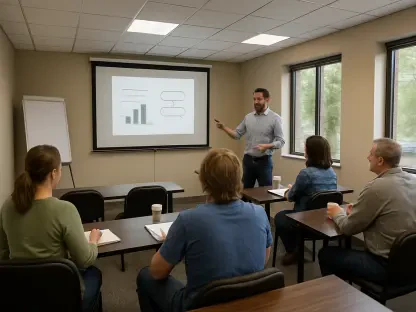In the heart of Indiana, a quiet but devastating crisis is unfolding as the state’s child care system teeters on the edge of collapse due to drastic funding cuts following the expiration of federal pandemic aid. Providers across the state, from small towns like Mooresville to urban centers like Indianapolis, are grappling with empty classrooms, staff layoffs, and looming closures. Families, particularly those with limited means, are caught in a bind—unable to afford quality care and forced to navigate a shrinking landscape of options. This isn’t just a problem for individual households; it’s a systemic failure that threatens the very foundation of early childhood education, with ripple effects that could impact generations. The story of Jen Palmer, who runs The Growing Garden Learning Center, encapsulates this struggle—once overwhelmed with demand, her center now faces a projected $33,000 deficit this year, a stark reflection of a broader statewide emergency.
The numbers behind this crisis are staggering, with Early Learning Indiana estimating a collective loss of $3.8 million weekly for child care providers due to reduced state support. This financial hemorrhage has translated into real-world consequences, as centers cut back on staff and services or shut down entirely. Meanwhile, nearly 31,000 children languish on voucher waitlists, with new enrollments frozen until at least 2027. Beyond the immediate hardship, the erosion of high-quality care risks long-term developmental setbacks for children, as experts warn of the lifelong benefits tied to early education. This deepening predicament demands a closer look at the scale of the cuts, the human toll, and the policy decisions—or lack thereof—that have brought Indiana to this critical juncture.
Funding Cuts: A Statewide Emergency
The Scale of Financial Loss
The financial devastation wrought by funding cuts in Indiana’s child care sector is nothing short of catastrophic, with providers facing unprecedented losses that jeopardize their very existence. Early Learning Indiana has calculated that the industry is bleeding approximately $3.8 million each week due to slashed reimbursement rates and the depletion of federal aid that once buoyed the system. This isn’t just a statistic—it’s a lifeline being severed for countless centers that relied on state support to serve low-income families. The Child Care and Development Fund (CCDF), a critical mechanism for funding vouchers, has been significantly undermined, leaving providers with no buffer to absorb the cuts. In towns like Martinsville and Mooresville, small centers that once thrived are now counting empty spots where children used to learn and play, a direct result of families losing access to subsidies. This financial strain isn’t just a temporary setback; it’s a structural unraveling that threatens to dismantle an essential service across the state, pushing providers to the brink of insolvency.
Compounding this fiscal nightmare is the ripple effect on local economies and community stability, as child care centers often serve as both employers and vital resources for working parents, who rely on them to balance their professional and personal lives. When a center like The Growing Garden Learning Center projects a $33,000 deficit in a single year, it’s not just the owner who suffers—employees face layoffs, and parents lose a trusted place for their children, forcing them to scramble for alternatives. These losses accumulate across Indiana, with weekly deficits piling up into millions, eroding the infrastructure of early education. Statewide, the cuts have created a vicious cycle: reduced funding leads to fewer enrolled children, which in turn slashes revenue further, making it nearly impossible for providers to maintain operations. The absence of a robust financial safety net from the state, especially after the expiration of over $1 billion in federal pandemic relief, has exposed the fragility of this sector, leaving many to wonder how long the system can endure under such relentless pressure.
Impact on Providers and Enrollment
For child care providers across Indiana, the funding cuts have translated into a harsh reality of dwindling enrollment and operational cutbacks that threaten their very survival. Centers like Purpose of Life Academy in Indianapolis and Learning Land Child Care in Martinsville have reported significant drops in the number of children they serve, a direct consequence of families losing access to state vouchers. Once-bustling facilities now stand with empty classrooms, unable to fill spots without the subsidies that made care affordable for low-income households. This decline isn’t merely a numbers game—it’s a fundamental erosion of a provider’s ability to cover basic costs like rent, utilities, and payroll. The freeze on new voucher enrollments, expected to persist until at least 2027, has left nearly 31,000 children on waitlists, a backlog that signals not just a current crisis but a prolonged barrier to access. Providers are caught in an impossible bind, forced to either raise fees beyond what most families can afford or operate at a loss.
Beyond the immediate enrollment challenges, the impact on providers extends to their capacity to deliver even basic services, as financial constraints force tough decisions about staffing and program offerings. Many centers have had to reduce their workforce—some, like Jen Palmer’s facility in Mooresville, now operate with nearly a third fewer staff members than before the cuts. This isn’t just about fewer hands on deck; it means less individualized attention for children and a diminished ability to meet educational and developmental needs. The funding reductions have also stalled expansion plans or improvements, with providers shifting focus from growth to mere survival. In this environment, the dream of building a robust child care network in underserved areas—often termed “child care deserts”—feels increasingly out of reach. As enrollment continues to plummet and resources dwindle, the very mission of these centers, to nurture and educate young minds, is being undermined by a lack of state commitment to their sustainability.
Quality at Risk: The Human Cost
Staff Reductions and Program Cuts
The human cost of Indiana’s child care funding cuts is painfully evident in the widespread staff reductions that have stripped centers of their capacity to maintain quality care. Providers across the state, including highly rated facilities like The Growing Garden Learning Center, have been forced to let go of valuable employees, with some operating at significantly reduced staff levels. This isn’t a minor adjustment—fewer staff members mean higher student-teacher ratios, less personalized attention, and a diminished ability to address the unique needs of each child. Programs that once offered specialized services, such as support for children with disabilities like autism, are now at risk of being scaled back or eliminated entirely due to budget constraints. The loss of trained professionals, often paid competitive wages between $15 and $20 per hour to ensure quality, sends a troubling signal that excellence in early education is no longer a feasible goal for many providers facing financial ruin.
Moreover, these staff cuts are accompanied by a broader erosion of program offerings that once defined high-quality child care in Indiana, leaving both providers and families in a precarious position as they struggle to adapt. Educational activities, enrichment programs, and even basic safety protocols suffer when there aren’t enough hands to manage daily operations. The funding reductions, which have slashed reimbursement rates by over 20% for top-rated centers as reported by Early Learning Indiana, have made it nearly impossible to sustain the infrastructure needed for comprehensive care. Providers are forced to prioritize bare-bones survival over innovation or improvement, a stark departure from the state’s earlier incentives for quality. This downward spiral not only impacts the children currently enrolled but also deters potential families from seeking care, further deepening the enrollment crisis. As programs are pared down, the essence of what made these centers vital community resources—nurturing environments for growth—is being sacrificed to balance the books.
Families Caught in the Crossfire
Families, particularly those with limited financial means, are bearing the brunt of Indiana’s child care crisis, trapped between unaffordable costs and shrinking access to reliable options, as the struggle to find stable care intensifies. With state vouchers frozen and waitlists stretching to nearly 31,000 children, parents face impossible choices: pay out-of-pocket fees that strain household budgets or settle for lower-quality, sometimes unlicensed, care arrangements. This dilemma often means children are shuffled between makeshift solutions, a situation Jen Palmer fears could lead to them “bouncing from house to house” as parents juggle work and caregiving. The stress of securing stable care while maintaining employment is a growing burden, especially in low-income areas already classified as child care deserts. For many, the loss of subsidized spots through the CCDF isn’t just an inconvenience—it’s a direct threat to family stability, forcing some parents to consider leaving the workforce altogether to care for their children themselves.
The emotional and practical toll on families extends beyond mere logistics, as the lack of quality child care disrupts the foundational security needed for both parental peace of mind and child well-being. When high-quality centers reduce staff or close due to funding cuts, parents lose trust in the system, unsure if their children are receiving the nurturing and educational support they need during critical developmental years. The ripple effects are profound—economic instability from reduced work hours, heightened stress from unreliable care, and the lingering worry that children are missing out on essential early learning opportunities. In communities across Indiana, this crisis is reshaping daily life, as families patch together solutions that often fall short of ideal. The absence of state intervention to restore voucher access or bolster provider funding leaves these households vulnerable, highlighting a glaring gap between policy priorities and the real needs of working parents striving to build a better future for their children.
Long-Term Consequences of Neglect
Developmental Impacts on Children
The long-term consequences of Indiana’s child care funding cuts are most acutely felt in the potential developmental setbacks for children denied access to high-quality early education, a critical foundation for their future success. Research from experts like Dana Charles McCoy, an associate professor at Harvard Graduate School of Education, underscores the transformative power of programs with low student-teacher ratios and well-trained staff. Such environments foster cognitive, social-emotional, and physical growth, yielding benefits that can persist into adulthood, including better academic outcomes and improved life chances. However, as funding reductions force centers to cut staff and scale back services, these critical elements are compromised. Children in understaffed or low-quality settings miss out on the structured learning and nurturing interactions that lay the groundwork for future success, a loss that could widen achievement gaps, particularly for those from disadvantaged backgrounds already facing systemic barriers.
This developmental neglect isn’t just a theoretical concern—it’s a tangible risk playing out across Indiana as access to quality care diminishes for thousands of young learners, with nearly 31,000 children stuck on voucher waitlists. High-rated programs are facing over 20% cuts in reimbursement rates, and the state is effectively sidelining a generation from the proven advantages of early education. The absence of consistent, enriching experiences during formative years can hinder language development, problem-solving skills, and emotional regulation, challenges that often compound over time. Families unable to secure spots in reputable centers may turn to less regulated options, where the lack of trained caregivers further exacerbates these risks. As the crisis deepens, the societal cost of failing to invest in early childhood education becomes clearer, with potential increases in future educational interventions and social services needed to address gaps that could have been prevented with adequate support now.
Erosion of High Standards
The erosion of high standards in Indiana’s child care system stands as another alarming long-term consequence of the current funding crisis, undermining years of progress toward quality improvement. Previously, the state incentivized excellence by offering higher reimbursement rates to top-rated facilities, encouraging providers to invest in staff training, better facilities, and specialized services. However, the recent cuts have disproportionately impacted these high-quality centers, with funding slashed by over 20%, according to Early Learning Indiana. This financial blow sends a disheartening message, as noted by Hanan Osman of the Indiana Association for the Education of Young Children, that quality is no longer a priority. Providers are pushed into survival mode, forced to abandon enhancements and focus on basic operations, a shift that risks reversing hard-won gains in early education standards across the state and diminishing the overall caliber of care available to children.
As high standards slip, the broader implications for Indiana’s child care landscape become increasingly dire, threatening to create a system where mediocrity becomes the norm rather than the exception. Centers once recognized for low student-teacher ratios or innovative curricula now struggle to maintain even minimal staffing levels, let alone pursue excellence. The loss of competitive wages—once a draw for skilled educators—further depletes the talent pool, leaving programs with less qualified staff or high turnover rates that disrupt continuity for children. This decline in quality doesn’t just affect current enrollees; it deters future families from trusting the system, perpetuating a cycle of disinvestment. Without a renewed commitment to funding that prioritizes and rewards high standards, Indiana risks a future where child care is merely a stopgap rather than a transformative stepping stone for young learners, undermining the state’s long-term educational and economic prospects in the process.
Policy Failures and Missed Opportunities
Loss of Federal Aid and State Inaction
The root of Indiana’s child care crisis lies in the loss of over $1 billion in federal pandemic aid that once expanded access to care for nearly 70,000 children through vouchers and preschool scholarships, drastically altering the support system for many families. This temporary lifeline, funneled through the Child Care and Development Fund (CCDF), transformed the landscape by making quality care affordable for low-income families and stabilizing providers with consistent funding. However, as this aid expired, the state failed to step in with a sustainable replacement, exposing a glaring gap in policy planning. The freeze on new voucher enrollments, projected to last until at least 2027, and the slashing of reimbursement rates have left providers and families reeling from the abrupt withdrawal of support. This inaction reflects a broader reluctance to treat child care as a critical public service, despite clear evidence of its importance during the pandemic shutdowns when expanded access proved both feasible and impactful for community resilience.
State-level inertia has only deepened the crisis, as Indiana’s response to the funding shortfall has been woefully inadequate, missing a crucial opportunity to build on the momentum of federal aid. While Governor Mike Braun advocated for increased state funding to bolster vouchers, lawmakers opted for a smaller, temporary budget increase, prioritizing fiscal caution over comprehensive investment amid gloomy revenue forecasts. This stopgap measure has done little to address the scale of the problem, leaving nearly 31,000 children on waitlists and providers facing weekly losses in the millions. Critics argue that this hesitance to commit long-term resources ignores the proven societal benefits of early education and the economic necessity of supporting working parents. The failure to sustain or expand programs like CCDF reveals a disconnect between policy decisions and the urgent needs on the ground, allowing a preventable crisis to spiral into a full-blown emergency for the state’s child care infrastructure.
Short-Term Fixes vs. Long-Term Investment
The tension between short-term fiscal restraint and the need for long-term investment in child care defines much of Indiana’s current policy landscape, with lawmakers favoring quick fixes over sustainable solutions. The decision to implement a modest, temporary budget increase—rather than a robust funding commitment—reflects a cautious approach driven by concerns over state revenue projections. While this measure prevented the immediate revocation of existing vouchers, it falls far short of addressing the systemic issues at play, such as frozen enrollments and slashed reimbursement rates. Nearly 31,000 children remain on waitlists, a backlog that underscores the inadequacy of patchwork responses in the face of a crisis described by advocates as a disaster. This focus on short-term stability risks perpetuating a cycle of underfunding, where providers and families are left to navigate recurring crises without a clear path to recovery or growth.
In contrast, the case for long-term investment in child care as a public policy priority has grown louder among experts and advocates, who warn that continued neglect will exact a steep societal cost. Quality early education isn’t just a service for families—it’s an economic engine that supports workforce participation and lays the groundwork for future productivity through improved child outcomes. Yet, the state’s reluctance to allocate significant resources, even after Governor Braun’s push for more funding, signals a missed opportunity to rebuild a resilient system after federal aid. Critics label this approach shortsighted, arguing that the price of inaction—developmental setbacks, family instability, and provider closures—far outweighs the upfront costs of investment. Without a shift toward policies that prioritize sustained funding and incentivize quality, Indiana risks entrenching a child care system that fails to meet the needs of its most vulnerable citizens, both now and in the years ahead.
Voices of Urgency: Advocates and Experts Speak Out
Child Care as a Public Good
Amid Indiana’s child care crisis, a growing chorus of advocates is reframing the issue as a public good rather than a private family burden, urging policymakers to recognize its broader societal value. Sam Snideman of the United Way of Central Indiana has been vocal in describing the funding cuts as a disaster, emphasizing that access to quality care underpins community stability and economic vitality. This perspective gained traction during the pandemic, when federal aid demonstrated how expanded support through programs like the CCDF could transform lives by enabling parents to work while ensuring children received early education. Advocates argue that child care is as essential as public schools or infrastructure, deserving of consistent state investment rather than sporadic, crisis-driven responses. The current rollback of support, leaving thousands of families and providers in limbo, is seen as a step backward from this emerging consensus, ignoring the interconnected benefits of a robust early education system.
This push to view child care through a public policy lens is bolstered by evidence of its far-reaching impact, challenging the notion that it’s solely a personal responsibility. High-quality programs not only support working parents but also reduce future societal costs by fostering child development that leads to better educational and economic outcomes. Yet, the state’s failure to sustain funding after federal aid—evidenced by frozen voucher enrollments and weekly provider losses of $3.8 million—undermines this vision. Advocacy groups stress that treating child care as a public good requires proactive measures, not reactive patches, to ensure equitable access, especially in underserved areas. The urgency of their message is clear: without a fundamental shift in how Indiana prioritizes this sector, the crisis will continue to disproportionately harm low-income communities, perpetuating cycles of inequality and missed opportunity that could have been mitigated with strategic, forward-thinking policy.
Warnings of Systemic Collapse
Experts and providers alike are sounding the alarm over the potential systemic collapse of Indiana’s child care framework, painting a dire picture of what lies ahead if funding isn’t restored. Hanan Osman of the Indiana Association for the Education of Young Children has highlighted how the cuts, particularly the over 20% reduction for high-rated facilities, signal a deprioritization of quality, pushing providers into a survival mindset rather than one of excellence. This isn’t just about individual centers closing—it’s about the erosion of an entire ecosystem that supports early learning and family stability. With nearly 31,000 children on voucher waitlists and no new enrollments expected until at least 2027, the backlog threatens to overwhelm what remains of the system. The warnings are stark: without immediate intervention, the infrastructure of child care in Indiana could crumble, leaving lasting scars on communities already struggling with limited resources.
In an effort to highlight the gravity of the situation, concerns are echoed by providers on the front lines, who fear that the current trajectory will lead to irreversible damage, both financially and developmentally, for the state’s youngest residents. Centers like The Growing Garden Learning Center, already projecting significant deficits, exemplify the precariousness of the situation—each closure or cutback reduces options for families and chips away at the network of care. Experts caution that the long-term consequences, including diminished child outcomes and increased economic strain on parents, will burden future generations and public systems far beyond the immediate crisis. The consensus is that temporary budget fixes are insufficient to avert this collapse; only a comprehensive reinvestment in child care, prioritizing both access and quality, can stabilize the sector. As these voices of urgency grow louder, they underscore a critical truth: Indiana stood at a crossroads when federal aid ended, and the path chosen thus far has led perilously close to a breaking point.








